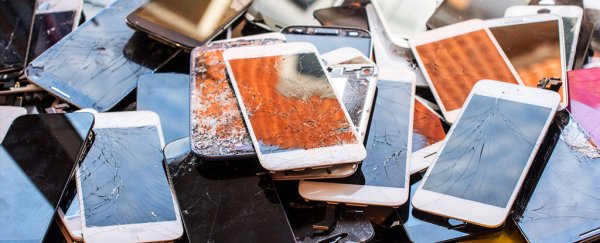Smartphone technology has improved rapidly in recent years, giving us more battery life, better performance, and improved photo-taking capabilities – but they still come with screens that have a tendency to crack after being knocked or dropped.
Scientists have made encouraging progress in developing lead halide perovskite (LHP) screens that offer top-quality brightness and clarity as well as excellent strength, and which could be fitted to the phones, televisions, and laptops of the future.
While the nanocrystal-based material has long been showing promise as a base for displays, it's very sensitive to light, heat, and water. At the moment, it only works as a screen technology in the rarified atmosphere of a lab.
Not only that, but it also has a tendency to leak toxic metal ions, which isn't ideal for a consumer electronics product. The latest research into LHP displays fixes a lot of these problems by trapping the LHP material inside glass.
"Our team of chemical engineers and material scientists has developed a process to wrap or bind the nanocrystals in porous glass," says chemical engineer Jingwei Hou, from the University of Queensland in Australia.
"This process is key to stabilizing the material, enhancing its efficiency, and inhibiting the toxic lead ions from leaching out from the materials."
Bonus points if you know that the nanocrystal-based perovskite material is also being looked at as a superior, next-gen base for solar panels. Not only can it work as a display, but it can also be adapted to turn sunlight into electricity.
The finished prototype product shows "high stability" when exposed to heat, light, air, and humidity, and was able to retain 80 percent of its luminescence after 10,000 hours of water immersion, the researchers behind the new study report.
We're still at the very early stages here. It's going to be years before the technology is ready to make unbreakable phone screens, but the addition of glass does take the science several significant steps further forward.
"At present QLED or quantum dot light-emitting diode screens are considered the top performer for image display and performance," says Hou. "This research will enable us to improve on this nanocrystal technology by offering stunning picture quality and strength."
Materials scientists are continuing to make big strides forward in terms of display technology, even if the length of time between a lab proof-of-concept and a finished product remains substantial.
Besides developing displays that can't crack in the first place, scientists are also developing screen technology that's able to heal itself when it's broken. Again though, it takes time for the materials to be scaled up and mass-produced.
The research detailed in this latest study should benefit all aspects of perovskite research – not only for its use in electronic displays but also for making it more stable and practical for deploying as part of a solar panel.
"Not only can we make these nanocrystals more robust but we can tune their opto-electronic properties with fantastic light emission efficiency and highly desirable white light LEDs," says chemical engineer Vicki Chen, from the University of Queensland.
"This discovery opens up a new generation of nanocrystal-glass composites for energy conversion and catalysis."
The research has been published in Science.
